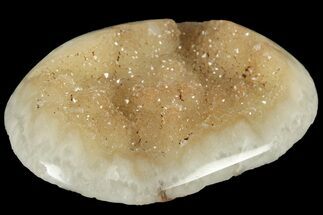This Specimen has been sold.
1.75" Amethyst and Calcite in Basalt - India
This is a beautiful, 1.75" wide specimen that features amethyst with a variety of calcite crystals, collected from Madhya Pradesh, India. This formation occurred within a cavity, or vug, in the basalt host rock. Apophyllite, barite, and julgoldite crystals have also been found within some of these vugs.
Amethyst is a purple variety of quartz (SiO2) that owes its violet color to natural gamma irradiation, iron impurities, and the presence of trace elements, which result in complex crystal lattice substitutions. It is considered a semi-precious gemstone, and just two centuries ago was considered to have a value on par with diamonds, sapphires, and rubies. The largest and best known amethyst deposits occur in southern Brazil and Uruguay, where they are found in hydrothermally-formed geodes, but many localities around the world produce an amazing variety of amethyst crystals and formations. They are almost always formed in medium- to high-temperature geological settings.
About Chabazite
Chabazite is an eye-catching mineral from the zeolite group, admired for its beautifully symmetrical crystal structure and pastel colors. Typically forming in rhombohedral or cubic-like crystals, chabazite often appears in hues of white, pink, orange, or light yellow. This mineral is primarily composed of hydrated calcium aluminum silicate, giving it a lightweight, porous structure that enables it to act as a natural ion-exchanger—a property commonly seen in zeolites.
Chabazite crystals have a vitreous to pearly luster, and their transparent to translucent appearance gives them an almost delicate, ethereal quality. With a hardness of about 4.5 to 5 on the Mohs scale, chabazite is moderately soft, making it suitable for display rather than wear. It typically forms in cavities within volcanic rocks like basalt and andesite, where it grows alongside other zeolite minerals such as heulandite, stilbite, and analcime. Some of the finest chabazite specimens come from Iceland, Italy, and India, renowned for their vivid color and well-formed crystals.
Chabazite is an eye-catching mineral from the zeolite group, admired for its beautifully symmetrical crystal structure and pastel colors. Typically forming in rhombohedral or cubic-like crystals, chabazite often appears in hues of white, pink, orange, or light yellow. This mineral is primarily composed of hydrated calcium aluminum silicate, giving it a lightweight, porous structure that enables it to act as a natural ion-exchanger—a property commonly seen in zeolites.
Chabazite crystals have a vitreous to pearly luster, and their transparent to translucent appearance gives them an almost delicate, ethereal quality. With a hardness of about 4.5 to 5 on the Mohs scale, chabazite is moderately soft, making it suitable for display rather than wear. It typically forms in cavities within volcanic rocks like basalt and andesite, where it grows alongside other zeolite minerals such as heulandite, stilbite, and analcime. Some of the finest chabazite specimens come from Iceland, Italy, and India, renowned for their vivid color and well-formed crystals.
About Calcite Crystals
Calcite crystals are a form of calcium carbonate (CaCO₃) known for their diverse shapes, transparency, and vibrant range of colors. They typically form in rhombohedral, scalenohedral, or prismatic shapes, often with well-defined, sharp edges and glossy surfaces. Calcite crystals are often translucent or transparent, sometimes displaying a double refraction effect where objects viewed through the crystal appear doubled. They can appear in various colors—white, clear, yellow, pink, blue, green, and orange—depending on impurities or trace minerals.
A notable characteristic of calcite is its reaction with weak acids like vinegar, which causes it to effervesce, or fizz, as it releases carbon dioxide. This property makes calcite crystals a key tool in geological identification and studies. Calcite forms in many environments, from sedimentary rocks like limestone and marble to hydrothermal veins.
Calcite crystals are a form of calcium carbonate (CaCO₃) known for their diverse shapes, transparency, and vibrant range of colors. They typically form in rhombohedral, scalenohedral, or prismatic shapes, often with well-defined, sharp edges and glossy surfaces. Calcite crystals are often translucent or transparent, sometimes displaying a double refraction effect where objects viewed through the crystal appear doubled. They can appear in various colors—white, clear, yellow, pink, blue, green, and orange—depending on impurities or trace minerals.
A notable characteristic of calcite is its reaction with weak acids like vinegar, which causes it to effervesce, or fizz, as it releases carbon dioxide. This property makes calcite crystals a key tool in geological identification and studies. Calcite forms in many environments, from sedimentary rocks like limestone and marble to hydrothermal veins.
SPECIES
Quartz var. Amethyst & Calcite
LOCATION
Khadakwani, Madhya Pradesh, India
SIZE
1.75 x 1.6"
CATEGORY
SUB CATEGORY
ITEM
#266957
 Reviews
Reviews












